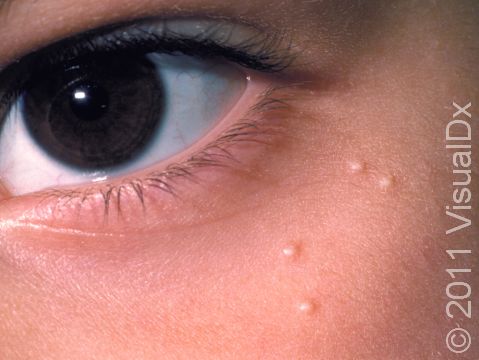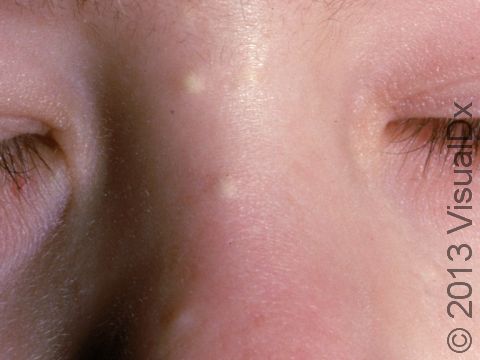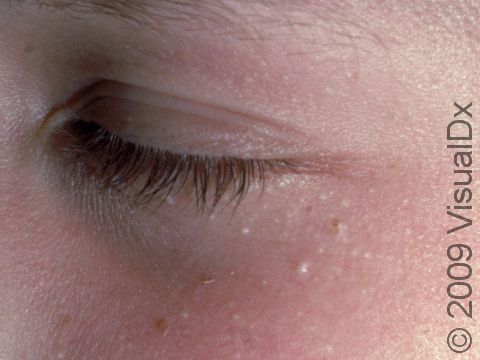Milia
Milia are commonly found on the skin of people of all ages. Milia formed directly from sloughed-off skin, known as primary milia, are small, keratin-filled cysts (enclosed lumps underneath the skin) usually found on the face, while lesions formed indirectly, known as secondary milia, are small cysts found within areas of skin affected by another skin condition, such as an injury, burn, or blistering of the skin.
Milia are formed when skin does not slough off normally but instead remains trapped in pockets on the surface of the skin. An individual milium (the singular of milia) is formed from a hair follicle or sweat gland.
Who's At Risk?
Milia can occur in people of any age, race / ethnicity, or sex.
Milia are especially common in newborns, but they can occur in children and adults.
Secondary milia may appear in affected skin of people with:
- A blistering injury (trauma) to skin, such as poison ivy.
- Burns.
- Blistering skin disorders, such as epidermolysis bullosa or porphyria.
- Long-term topical steroid use.
Signs & Symptoms
A single milium appears as a small (1-2 mm), white-to-yellow, dome-shaped cyst on the outer surface of the skin.
In children, milia most commonly occur on the cheek, around the eyes, and on the nose or chin. They are sometimes also seen on the genital skin.
Self-Care Guidelines
Although milia are found in the superficial layers of skin, do not try to remove them at home as you may leave a scar.
Primary milia found in younger children (mainly infants) tend to heal on their own within several weeks, though the secondary milia found in older children tend to be long-lasting.
Treatments
If the medical professional diagnoses primary milia, no treatment is necessary as the condition will go away on its own within a few weeks.
If your child has secondary milia, the medical professional will likely treat the other skin condition at that area, if it is still present. Although no treatment is needed for the milia, if removal is desired, the medical professional may:
- Prescribe a topical retinoid cream such as tretinoin, tazarotene, or adapalene.
- Remove each milium with a sterile blade or scalpel followed by removal of the keratin with the use of a special tool called a comedone extractor.
Visit Urgency
See your child’s medical professional for evaluation if you notice any new cyst on the child’s skin.
Trusted Links
References
Bolognia J, Schaffer JV, Cerroni L. Dermatology. 4th ed. Philadelphia, PA: Elsevier; 2018.
James WD, Elston D, Treat JR, Rosenbach MA. Andrew’s Diseases of the Skin. 13th ed. Philadelphia, PA: Elsevier; 2019.
Kang S, Amagai M, Bruckner AL, et al. Fitzpatrick’s Dermatology. 9th ed. New York, NY: McGraw-Hill Education; 2019.
Paller A, Mancini A. Paller and Mancini: Hurwitz Clinical Pediatric Dermatology. 6th ed. St. Louis, MO: Elsevier; 2022.
Last modified on October 6th, 2023 at 2:56 pm

Not sure what to look for?
Try our new Rash and Skin Condition Finder


